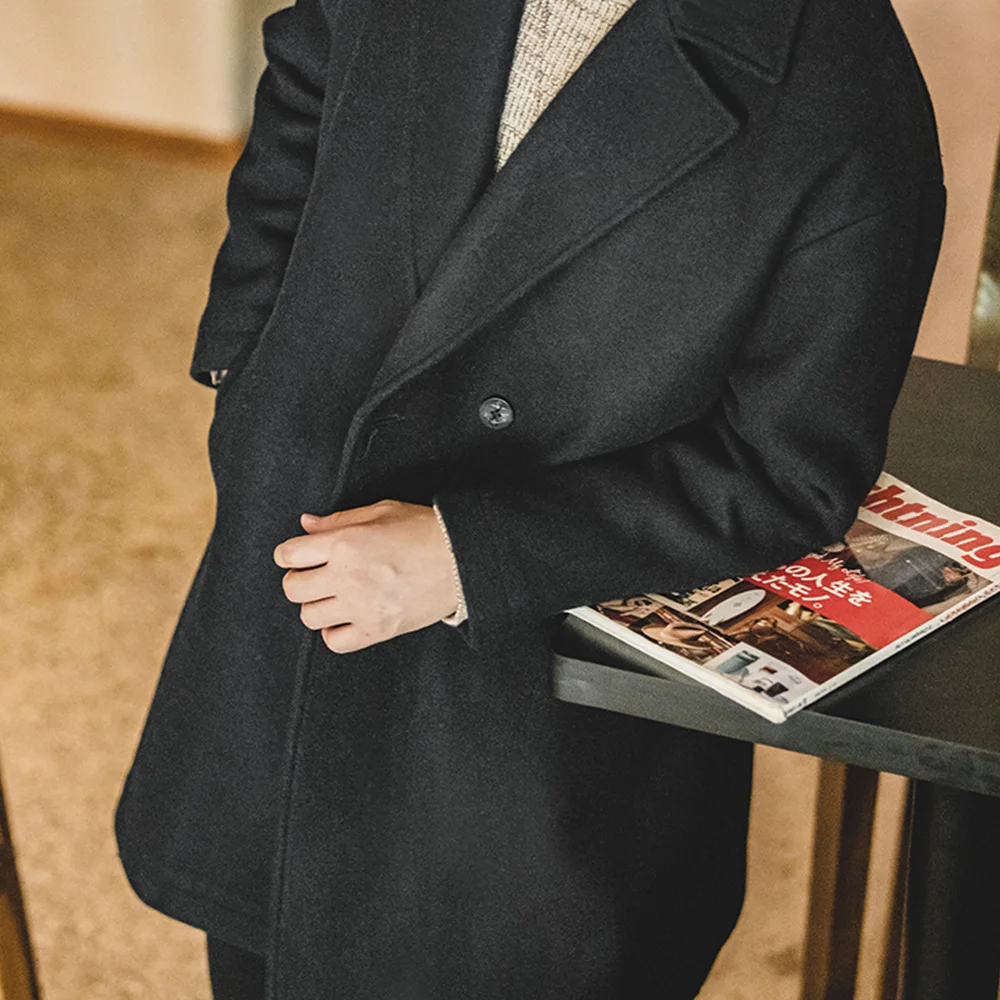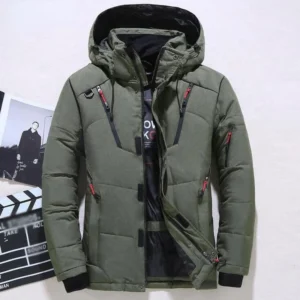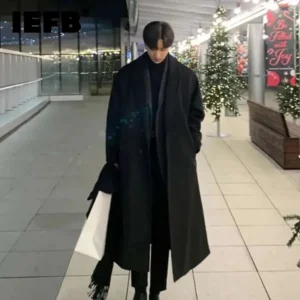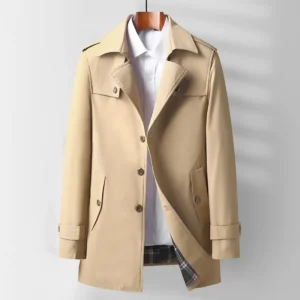The Tall Man’s Dilemma: Why Finding the Right Long Overcoat Matters
Finding the perfect long overcoat as a tall man can feel like searching for a needle in a haystack. While height brings many advantages, it comes with unique challenges when shopping for outerwear that fits properly and looks proportionate.
For tall men, the frustrations are all too familiar:
- Sleeves that end inches above your wrists, exposing your suit or shirt underneath
- Coat bodies that hit at awkward mid-thigh positions rather than the intended knee or below
- Shoulders that pinch or restrict movement because the overall proportions are wrong
- A general sense that the garment was designed for someone with completely different dimensions
These aren’t just aesthetic concerns. When winter winds blow, those too-short sleeves mean cold wrists. An inadequate coat length leaves your legs exposed to the elements. Beyond comfort and function, there’s also the matter of presentation—a poorly fitted overcoat can undermine an otherwise polished appearance.
The right long overcoat should enhance your height rather than fight against it. When properly fitted, a quality overcoat creates a commanding silhouette that projects confidence and style, complementing your natural proportions rather than emphasizing fit issues.
This comprehensive guide will walk you through understanding proper coat length considerations for tall men and provide practical solutions for finding that elusive perfect fit. We’ll explore everything from key measurements to fabric selection, ensuring you can make an informed choice for this significant wardrobe investment.
When selected thoughtfully, a quality long overcoat becomes a cornerstone piece in your wardrobe, versatile enough to enhance both formal and casual outfits. Let’s begin the journey to finding your perfect long overcoat designed for taller frames.
Understanding the Perfect Fit: What to Look for in an Overcoat as a Tall Man
Achieving the perfect fit in an overcoat requires understanding specific measurement points that are particularly crucial for tall men. When these key dimensions align with your body, the result is both comfortable and visually balanced.
Key Measurement Points
Overall Length: For tall men, coat length is perhaps the most critical dimension. A properly fitted overcoat should:
– Fall somewhere between just above the knee and mid-calf
– Provide proportional coverage (taller men often need longer coats)
– Create a balanced silhouette from shoulder to hem
Sleeve Length: Coat sleeves should:
– Extend approximately ¼ to ½ inch beyond your suit jacket sleeves
– Cover your wrists completely, even when arms are extended
– End at the base of your thumb when arms are relaxed at your sides
Shoulder Fit: Proper shoulder fit is foundational for overall comfort:
– The seam should sit precisely at the edge of your shoulder
– You should have full range of motion without pulling or restriction
– The shoulders should lie flat without bunching or sagging
Body Proportions: The coat’s body should:
– Allow space for layering without looking bulky
– Create a clean line from shoulders to hem
– Taper subtly at the waist for shape while maintaining ease of movement
Tall vs. Big & Tall: Understanding the Distinction
It’s important to differentiate between “Tall” and “Big & Tall” sizing:
Tall sizing: Designed for men who are above average in height but not necessarily in width. These garments feature longer sleeves and body lengths while maintaining standard chest, waist, and shoulder proportions.
Big & Tall sizing: Created for men who need both additional height accommodation and more room through the chest, shoulders, and waist. These options offer both extended lengths and wider proportions.
Choosing between these categories depends on your specific body type. Many tall men with athletic or slim builds find that true “Tall” sizes offer the best fit, while those with broader frames may benefit from specialized options for tall men with broader builds.
Self-Measuring for the Ideal Fit
To determine your ideal overcoat dimensions:
- Back Length: Measure from the base of your collar to the point where you want the coat to end (typically mid-knee)
- Sleeve Length: Measure from shoulder seam to just past your wrist bone
- Chest: Measure around the fullest part of your chest, under your arms
- Shoulders: Measure from one shoulder edge to the other across your back
When examining comprehensive guidance on proper coat measurement points, remember that these measurements form the foundation of your search. Armed with these specific numbers, you’ll be better equipped to evaluate potential options, whether shopping online or in stores.
The difference between a good fit and a perfect fit lies in these details—details that transform an ordinary garment into one that looks custom-made for your tall frame.
Essential Overcoat Styles That Complement Tall Physiques
Certain overcoat styles naturally complement taller frames, enhancing proportion and creating a polished appearance. Understanding these classic styles and their specific benefits for tall men will help you make more informed choices.
Chesterfield Overcoats
The Chesterfield represents timeless elegance with clean lines that particularly flatter height:
- Features a single-breasted front with a concealed placket for a sleek silhouette
- Typically falls to the knee, creating balanced proportions
- Lacks a belt, maintaining the long, unbroken line that showcases height
- Often includes a velvet collar for a touch of sophistication
For tall men, the Chesterfield’s clean vertical lines emphasize height in a refined way, making it an excellent option for formal occasions and business wear.
Trench Coats
The classic trench offers versatility with adjustable features that work well for tall frames:
- Double-breasted front with a belt to define waist proportion
- Typically extends below the knee, providing good coverage
- Raglan sleeves offer generous movement and accommodate longer arms
- Adjustable cuffs to accommodate different arm lengths
The belted waist of a trench creates a defined middle point that breaks up height in a flattering way, while the longer length maintains elegant proportion.
Ulster/Polo Coats
These more casual options provide substantial presence for taller men:
- Often feature wider lapels and a more relaxed fit
- Typically double-breasted with a half-belt or full belt
- Usually made from heavier fabrics with texture (like tweed)
- Length typically reaches to mid-calf, providing excellent coverage
The Ulster’s robust appearance and generous proportions create a commanding presence that works harmoniously with a tall frame.
Double-Breasted vs. Single-Breasted
When considering double-breasted styles that complement tall frames, note these distinctions:
Double-Breasted:
– Creates horizontal interest that breaks up height
– Offers more chest coverage and warmth
– Projects a bold, classic aesthetic
– Works particularly well for tall, slim builds
Single-Breasted:
– Creates a cleaner, more streamlined look
– Often more versatile for different occasions
– Generally appears more contemporary
– Works for all tall body types
Length Considerations
The ideal coat length is a critical decision for tall men. Guidance on selecting ideal coat length based on height suggests:
- Mid-thigh length: Modern, more casual option
- Knee-length: Versatile classic proportion
- Below-knee/calf-length: Traditional, offers maximum coverage and dramatic silhouette
Your personal style and practical needs should guide this choice—formal settings often call for longer lengths, while shorter options can work better for casual environments.
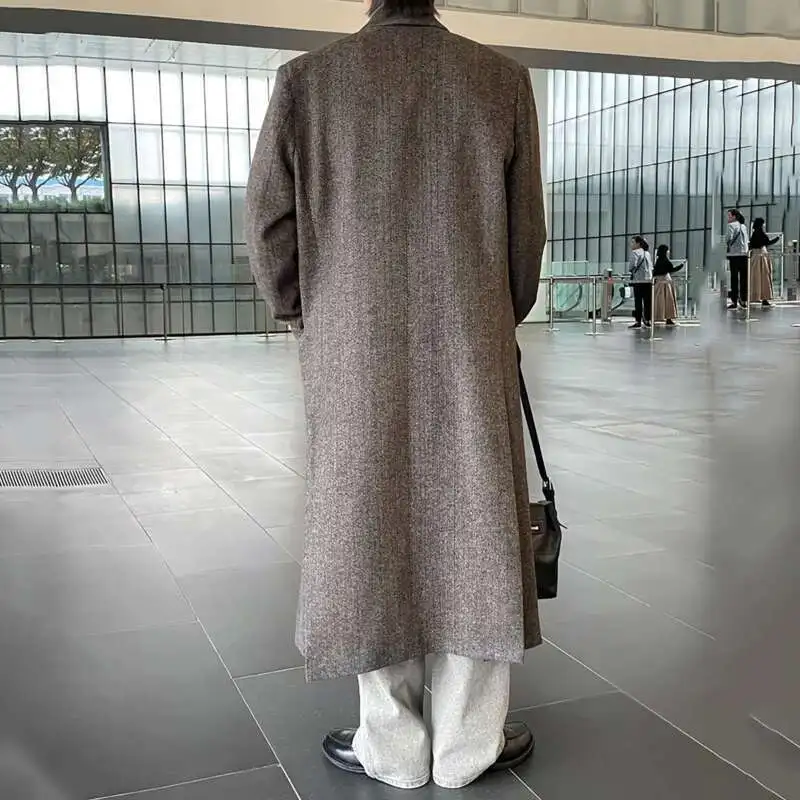
Each style offers unique advantages, but the common thread is proper proportion. When selecting between these classic designs, consider both your personal style and practical needs to find the overcoat that best serves your wardrobe.
Fabric and Material Selection for Maximum Impact
The fabric of your overcoat significantly influences not only its appearance but also how it drapes on your tall frame. For tall men, material selection is especially important as it affects the coat’s ability to maintain proper proportion and structure.
Wool Varieties
Wool remains the gold standard for quality overcoats, with several varieties offering distinct benefits:
Pure Wool: Available in different weights (18-24 oz is ideal for winter), providing excellent insulation while maintaining structure. The natural drape of wool complements tall frames by flowing with the body’s lines rather than standing away stiffly.
Merino Wool: Finer and softer than standard wool, merino creates a more refined appearance while offering excellent temperature regulation. Its smoother finish creates clean lines that enhance a tall silhouette.
Lambswool: Particularly soft and resilient, lambswool provides warmth without excessive weight. Its natural elasticity accommodates movement well, important for tall men who need fabrics that adjust to longer limbs.
When exploring quality wool overcoat options for tall men, look for tightly woven fabrics that hold their shape over time.
Cashmere and Luxury Blends
For those seeking premium options:
Pure Cashmere: Extraordinarily soft with excellent insulation, cashmere drapes beautifully on tall frames. Its lightweight nature creates a refined silhouette without bulkiness.
Wool-Cashmere Blends: Often featuring 10-30% cashmere mixed with wool, these blends offer enhanced softness and drape while maintaining structure and reducing cost compared to pure cashmere.
Camel Hair: With its distinctive color and exceptional insulation, camel hair creates a sophisticated statement coat with excellent drape for tall physiques.
These luxury options typically command higher prices but offer unmatched comfort and elegance that particularly complement taller frames.
Tweed and Textured Fabrics
Textured fabrics add visual interest that works particularly well on tall men:
Harris Tweed: This durable, handwoven wool fabric provides excellent weather protection with distinctive texture and depth.
Herringbone and Houndstooth: These classic patterns add horizontal visual interest that breaks up height in a sophisticated way.
Bouclé and Textured Weaves: These fabrics add dimension and character, creating visual interest across the expanse of a tall frame.
For tall men, textured fabrics can help balance proportions by adding visual weight and complexity to the silhouette.
Technical Fabrics
Modern technical fabrics offer functional benefits while maintaining style:
Wool-Synthetic Blends: Often including small percentages of nylon or polyester for durability and water resistance.
Performance Wool: Treated natural wool that offers water and stain resistance without sacrificing natural drape.
Microfiber Blends: Lightweight options that provide excellent insulation and weather resistance for transitional seasons.
The weight of the fabric directly impacts how an overcoat hangs on a tall frame. Heavier fabrics (20-24 oz) provide structure and stability, while medium-weight options (16-20 oz) offer versatility across seasons. The right fabric should complement your build while meeting your practical needs for warmth and weather protection.
Where to Find Quality Long Overcoats for Tall Men
Finding retailers that consistently offer well-proportioned overcoats for tall men requires knowing where to look. The landscape has improved significantly in recent years, with more options available across different price points.
Specialized Tall Men’s Retailers
Dedicated tall men’s clothing stores offer the most consistent sizing and proportions:
- These retailers specifically design garments with extended sleeves, longer bodies, and properly adjusted proportions
- Their standard sizes typically start where regular sizing ends (typically 6‘2” and above)
- Sales staff are usually knowledgeable about tall-specific fit issues
- Selection often includes multiple length options within the tall category
The primary advantage of these retailers is their focused expertise—their entire business revolves around understanding the needs of taller customers.
Department Stores with Dedicated Tall Sections
Many major department stores now maintain specific tall men’s departments:
- Look for “T” designations after regular sizes (42T, 44T)
- These sections often carry extended size ranges from multiple brands
- In-store alterations services can further customize fit
- Selection varies widely between locations, with flagship stores typically offering more options
When shopping department stores, call ahead to confirm their tall section includes outerwear specifically, as some focus primarily on suits and basic apparel.
Online Retailers with Detailed Sizing
E-commerce has revolutionized shopping for tall men by providing:
- Detailed measurement charts with specific sleeve and body lengths
- Customer reviews often mention fit details relevant to tall shoppers
- Filtering options to show only tall-specific items
- Liberal return policies that allow risk-free trial
When shopping online, look for retailers that provide comprehensive measurements rather than just S/M/L/XL designations. Understanding optimal coat lengths that enhance height helps you evaluate online options more effectively.
Evaluating Product Descriptions
Whether shopping online or in-store, learn to identify these key indicators in product descriptions:
- Specific sleeve length measurements (not just S/M/L)
- Body length measurements from collar to hem
- Terms like “tall fit,” “extended sizing,” or “long length”
- Customer reviews from other tall shoppers
The most valuable reviews often come from customers who mention their height and build, allowing you to compare their experience to your own proportions.
Made-to-Measure and Custom Options
For the perfect fit, consider made-to-measure services:
- Online made-to-measure platforms now make custom overcoats more accessible
- Traditional tailors can create fully custom options with perfect proportions
- Some ready-to-wear brands offer customization programs for their core styles
- Department store tailoring services can sometimes modify standard overcoats to better fit tall frames
While custom options typically command higher prices, the investment often proves worthwhile for tall men who have struggled to find ready-made coats with proper proportions.
Investment Considerations: Balancing Quality and Budget
A quality overcoat represents a significant investment, but one that pays dividends in longevity, appearance, and comfort. Understanding the relationship between price points and quality helps tall men make informed decisions about where to allocate their budget.
Price Range Expectations
Overcoat pricing typically follows these general tiers:
- Entry-level ($150-300): Basic wool blends, simpler construction, limited tall-specific options
- Mid-range ($300-700): Better wool quality, more refined details, increased tall size availability
- Premium ($700-1,200): High-quality natural fibers, superior construction, possible made-to-measure options
- Luxury ($1,200+): Exceptional materials (cashmere, vicuña), hand-tailoring, bespoke options
For tall men, the mid-range and premium categories often provide the best balance between quality and proper proportions, as these manufacturers typically invest more in specialized sizing.
Key Quality Indicators Worth the Investment
When evaluating overcoats, these features justify higher price points:
- Canvassed Construction: Full or half-canvas construction provides superior drape and longevity compared to fused alternatives
- Natural Fiber Content: Higher percentages of wool, cashmere, or other natural fibers improve comfort, drape, and temperature regulation
- Hand-Finished Details: Hand-sewn buttonholes, pick-stitching, and hand-attached linings indicate meticulous construction
- Quality Closures: Horn or corozo buttons, heavy-duty zippers, and reinforced button points ensure long-term functionality
For tall men, proper construction is particularly important as it ensures the coat maintains its intended shape and proportions over years of wear.
Cost-Per-Wear Analysis
A helpful framework for evaluating value involves considering:
- Versatility: How frequently the coat can be worn across different contexts
- Longevity: Expected years of service (quality overcoats can last decades with proper care)
- Timelessness: Resistance to fashion cycles and trend obsolescence
When analyzing guidance on quality wool overcoats for tall men, consider that dividing the purchase price by estimated wears often reveals that higher-quality options represent better long-term value despite higher initial costs.
Construction Quality Indicators
Look for these hallmarks of superior construction:
- Densely sewn seams with tight, even stitching
- Patterns that align perfectly at seams
- Smooth, even lining installation without puckering
- Substantial internal structure that maintains shape
- Reinforcement at stress points (pocket openings, vents)
These details contribute significantly to both appearance and longevity—particularly important considerations for tall men who face limited replacement options.
Versatility Features
Features that enhance adaptability and extend wearability include:
- Removable insulation layers for temperature flexibility
- Water-resistant treatments that maintain appearance in various conditions
- Thoughtful pocket placement and design for functionality
- Classic styling that works across formal and casual contexts
Investing in versatile design means your coat can serve multiple purposes throughout your wardrobe, maximizing its utility and value.
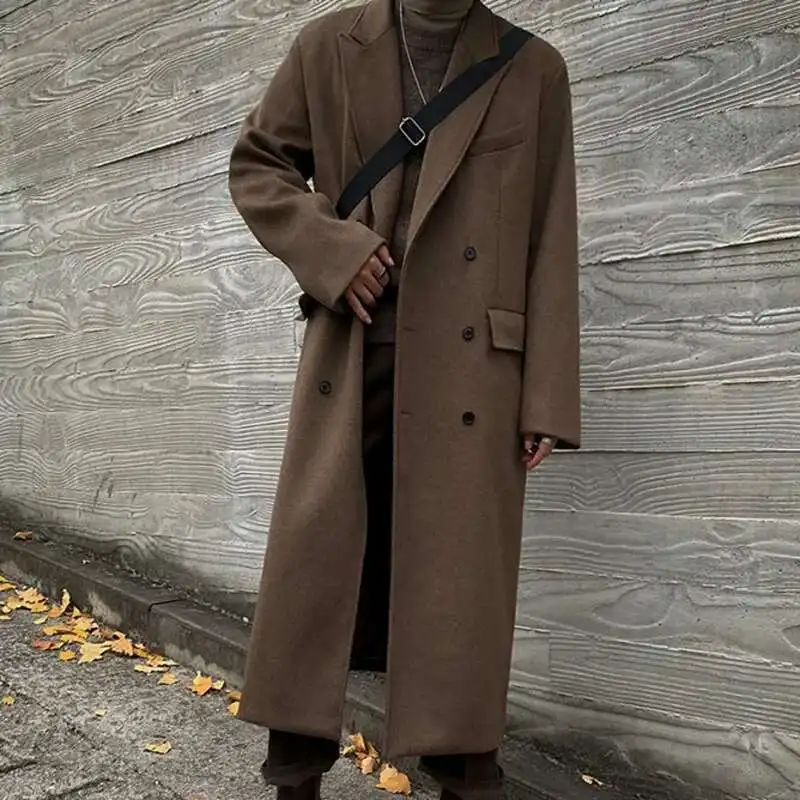
Styling a Long Overcoat for Tall Men: Maximizing Versatility
A well-chosen overcoat can serve as a versatile cornerstone in a tall man’s wardrobe, transitioning seamlessly between formal and casual contexts with the right styling approach.
Formal Occasions: Creating a Refined Silhouette
For business and formal settings, your overcoat should complement tailored clothing underneath:
- Pair a charcoal or navy single-breasted overcoat with similarly toned suits for a sophisticated monochromatic look
- Ensure your coat extends 4-6 inches below your suit jacket for proper proportion
- Match the shoulder width of your coat to accommodate suit jackets without excess bulk
- Consider formal overcoat options for tall men that feature clean lines and minimal detailing for maximum elegance
When worn over formal attire, your overcoat should enhance rather than compete with your suit. The overall effect should be refined and intentional, with consistent color tones creating a harmonious appearance.
Business Casual: Striking the Perfect Balance
For less formal professional environments:
- Layer a camel or medium gray overcoat over blazers and dress trousers
- Experiment with subtle contrast between your coat and inner layers
- Consider texture mixing—a smooth wool coat over a textured blazer creates sophisticated visual interest
- Opt for versatile neutrals that complement multiple outfits in your professional wardrobe
The key to business casual styling is maintaining polish while introducing elements of personality through texture, subtle pattern, or accessory choices.
Casual Styling: Elevating Everyday Wear
Even with jeans and casual attire, an overcoat adds refinement:
- Pair a textured overcoat (tweed, herringbone) with dark jeans and boots
- Layer over casual knitwear for an effortless smart-casual approach
- Consider deeper colors (burgundy, forest green) to distinguish from business wear
- Experiment with comparing coat length options for different occasions to find the right balance for casual settings
The contrast between a structured overcoat and casual underpinnings creates a thoughtfully assembled look that works particularly well for tall men, as it maintains proportion while adding sophistication to simple basics.
Layering Techniques for Tall Frames
Proper layering creates both visual interest and practical warmth:
- Use thin, high-quality layers rather than bulky ones to maintain a clean silhouette
- Create color depth by gradually shifting tones from inner to outer layers
- Ensure each visible layer (shirt collar, sweater, scarf) contributes to the overall color story
- Allow approximately half an inch of each layer to show at collar and cuffs for dimensional effect
For tall men, thoughtful layering breaks up height into visually pleasing segments while maintaining overall proportion.
Accessorizing Effectively
The right accessories enhance your overcoat’s impact:
- Choose scarves with sufficient length (at least 70 inches) to properly wrap around a tall frame
- Select gloves that extend beyond the wrist to ensure coverage when reaching
- Consider hat styles that balance your height (wider brims create horizontal visual interest)
- Choose footwear with visual weight to ground your silhouette
Accessories offer opportunities to introduce color and pattern while adding functional benefits during cold weather.
Mens Big and Tall Winter Coats, Mens Down Coat, Mens Hooded Winter Coat, Mens Puffer Coat
Price range: $126.44 through $217.01 Select options This product has multiple variants. The options may be chosen on the product pageMens Big and Tall Winter Coats, Mens Hooded Winter Coat
Price range: $80.32 through $106.68 Select options This product has multiple variants. The options may be chosen on the product pageMens Black Overcoat, Mens Black Wool Coat, Mens Wool Overcoat
$339.18 Select options This product has multiple variants. The options may be chosen on the product pageMens Grey Overcoat, Mens Wool Blend Coat, Mens Wool Overcoat
$201.28 Select options This product has multiple variants. The options may be chosen on the product pageMens Herringbone Coat, Mens Long Overcoat, Mens Wool Overcoat
Price range: $197.16 through $203.69 Select options This product has multiple variants. The options may be chosen on the product pageMens Long Overcoat, Mens Topcoats
Price range: $189.40 through $196.88 Select options This product has multiple variants. The options may be chosen on the product page
A well-styled overcoat creates a versatile foundation that can be adapted across multiple settings in your wardrobe. By understanding these styling principles, tall men can maximize the versatility of their investment while creating consistently polished appearances.
Care and Maintenance for Longevity
Proper care extends the life of your overcoat significantly, protecting your investment and ensuring it continues to perform and look its best year after year. For tall men who have invested time finding the perfect fit, this maintenance becomes especially important.
Proper Storage Techniques
When not in use, your overcoat requires thoughtful storage:
- Use wide, shaped wooden hangers designed for outerwear to maintain shoulder shape
- Allow adequate space between coats to prevent crushing and maintain air circulation
- Store in breathable garment bags that protect from dust while allowing fabric to breathe
- Never store in plastic dry cleaning bags, which trap moisture and can lead to mildew
- Hang in a cool, dry location away from direct sunlight to prevent fading
Before seasonal storage, ensure your coat is completely clean and fully dry to prevent moth damage and odor development.
Cleaning Recommendations by Fabric Type
Different materials require specific cleaning approaches:
Wool and Wool Blends:
– Dry clean only, typically 1-2 times per season at most
– Spot clean minor stains with a damp cloth and mild soap
– Air out after wearing before returning to storage
Cashmere and Luxury Fibers:
– Professional dry cleaning only, ideally at establishments specializing in luxury garments
– Hand steaming can refresh between cleanings
– Store with cedar blocks rather than mothballs for gentler protection
Technical Fabrics:
– Follow manufacturer guidelines precisely
– Some may allow gentle machine washing on specific cycles
– Air dry thoroughly before storing
Over-cleaning can damage fibers and break down the coat’s structure, so limit full cleaning to when truly necessary.
Professional vs. At-Home Care
While professional care is sometimes necessary, regular maintenance can happen at home:
- Use a soft-bristled clothes brush to remove surface dust and debris after wearing
- Steam (not iron) to remove minor wrinkles and refresh the fabric
- Use lint rollers or tape to remove pet hair and lint
- Address small stains immediately with appropriate spot treatments
Reserve professional cleaning for significant soiling or end-of-season preparation.
Seasonal Maintenance Routine
Develop a consistent care schedule:
Beginning of Season:
– Remove from storage and inspect for any issues
– Steam to remove storage wrinkles
– Check and repair any loose buttons or seamsDuring Season:
– Brush down after each wearing
– Allow 24 hours rest between wearings when possible
– Use a good quality lint roller regularlyEnd of Season:
– Clean professionally if needed
– Make any necessary repairs
– Store properly with appropriate moth protection
This systematic approach ensures your coat remains in peak condition throughout its life.
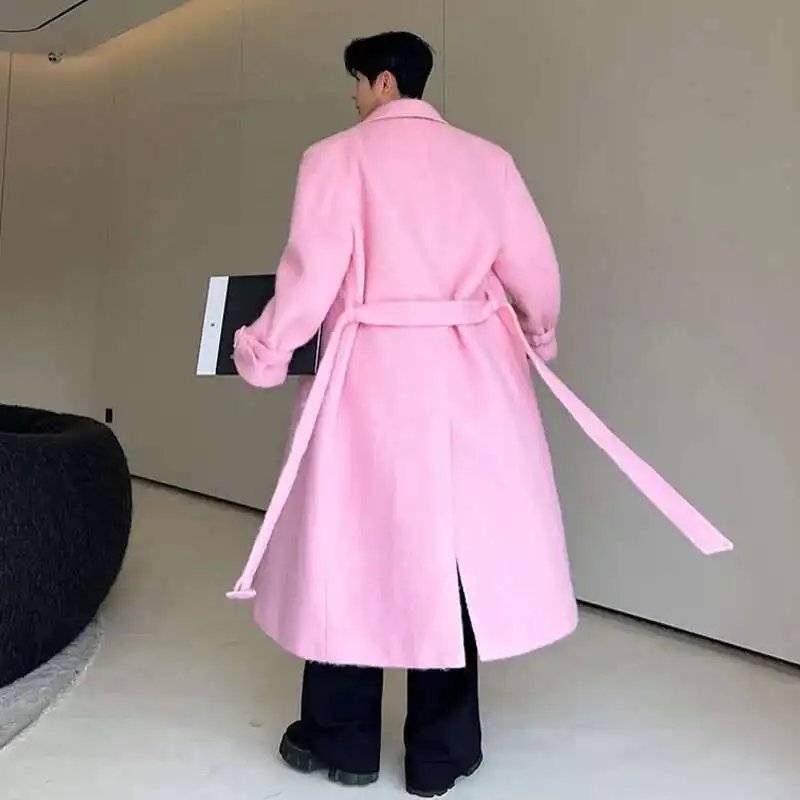
Common Issues and Prevention
Proactively address these typical problem areas:
- Wear at Cuffs and Collar: Consider preventative reinforcement of these high-friction areas
- Button Strain: Have buttons repositioned or reinforced if they show signs of stress
- Lining Tears: Repair small lining rips immediately before they expand
- Pocket Stretching: Avoid overloading pockets with heavy items
- Moth Damage: Use cedar, lavender, or specialized moth deterrents during storage
With proper care, a quality overcoat can serve you for decades rather than seasons, making your careful selection process even more worthwhile.
Frequently Asked Questions About Long Overcoats for Tall Men
Can tall men wear double-breasted overcoats?
Yes, tall men can absolutely wear double-breasted overcoats—in fact, many style experts consider this silhouette particularly flattering for taller frames. The horizontal lines created by the overlapping front panels help balance height, while the additional fabric provides proper coverage. The key is ensuring proper proportions: look for models with correctly positioned buttons and belts that hit at your natural waistline rather than above it.
What exactly makes an overcoat “tall-sized”?
A properly designed tall-sized overcoat features specific proportional adjustments beyond simply adding length. These include: extended sleeve length (typically 1-2 inches longer than standard), increased body length (often 2-4 inches longer), proportionally adjusted button and pocket placement, and sometimes slightly broader shoulders to maintain balance. True tall sizing adjusts all dimensions proportionally rather than simply extending the bottom hem.
Which overcoat styles work best for business versus casual wear?
For business environments, single-breasted Chesterfield or fly-front overcoats in navy, charcoal, or black project professionalism and pair seamlessly with suits. For casual settings, consider Ulster coats, relaxed trench styles, or textured options in colors like camel, olive, or patterns like herringbone. The distinctions primarily involve structure (more for business, less for casual), fabric texture (smoother for business, more textured for casual), and color (darker and more solid for business, more varied for casual).
How do custom overcoats compare to off-the-rack tall sizes?
Custom overcoats offer precise fit tailored to your specific proportions, ideal for tall men with unique measurement ratios or who fall outside standard tall sizing. They typically provide more fabric and construction options and allow personalized design details. The tradeoffs include higher cost (typically starting at twice the price of ready-to-wear), longer waiting periods (2-8 weeks), and the need for accurate measurements. For tall men with standard proportions, quality ready-made tall sizes often provide excellent fit at more accessible price points, while those with more specific needs may find the custom investment worthwhile.
Do certain fabrics work better for tall men’s overcoats?
While fabric choice is largely personal preference, certain qualities benefit tall frames. Fabrics with sufficient weight (20-24 oz) maintain proper drape over larger surface areas without collapsing or crinkling. Materials with natural elasticity accommodate longer limbs during movement. Vertical patterns (herringbone, subtle pinstripes) can complement height, while prominent horizontal patterns may need careful consideration. The most important factor is quality—better fabrics maintain their structure and appearance across the larger surface area of a tall man’s coat.
How can I tell if an overcoat will fit properly when shopping online?
When shopping for specialized long winter coat options for tall men online, focus on detailed measurements rather than size labels. Compare the garment’s specific sleeve length, body length, chest, and shoulder measurements to your own. Look for customer reviews from buyers who mention their height. Pay special attention to terms like “tall,” “long,” or “extra long” in product descriptions, and check the model’s height in product photos. Many retailers now include fit calculators that recommend sizes based on your specific measurements, which can be particularly helpful for tall shoppers.
Making Your Final Decision: A Practical Checklist
After exploring all aspects of selecting the perfect long overcoat, use this structured checklist to guide your final decision-making process:
Establish your primary fit priorities based on your specific proportions. Determine which dimensions are most critical for your comfort and appearance—whether it’s sleeve length, overall coat length, or shoulder width.
Identify your style preference by considering your typical wardrobe and where this coat will fit. Are you seeking a formal option for business attire, a versatile all-purpose coat, or a casual statement piece?
Set a realistic budget range that considers the coat as a long-term investment. Remember that quality construction and materials directly impact longevity, especially important when finding specialized tall sizes.
Determine whether off-the-rack tall sizing or custom options are more appropriate for your needs. Consider your timeline, budget constraints, and how closely standard tall sizing typically fits your frame.
Assess your climate and typical wearing conditions to guide fabric weight and feature selection. Consider temperature ranges, precipitation, and how these factors influence your material and style requirements.
Consider your maintenance capacity and willingness to care for different fabric types. Be realistic about whether you’ll follow through with specialized care requirements for more delicate materials.
Evaluate versatility requirements based on your lifestyle and existing wardrobe. Consider color, style, and design elements that will integrate well with your typical attire across different contexts.
Consult detailed style guidance for selecting the right coat length and proportions to make final adjustments to your selection criteria.
By systematically addressing each of these considerations, you’ll narrow your options to those overcoats that truly meet your specific needs as a tall man. This methodical approach helps ensure that your investment delivers both immediate satisfaction and long-term value.
Remember that finding the perfect overcoat is about more than just accommodating height—it’s about finding a garment that enhances your natural proportions while meeting your practical needs for warmth, style, and versatility. When these elements align, your overcoat becomes not just a winter necessity but a signature piece that elevates your entire wardrobe.

